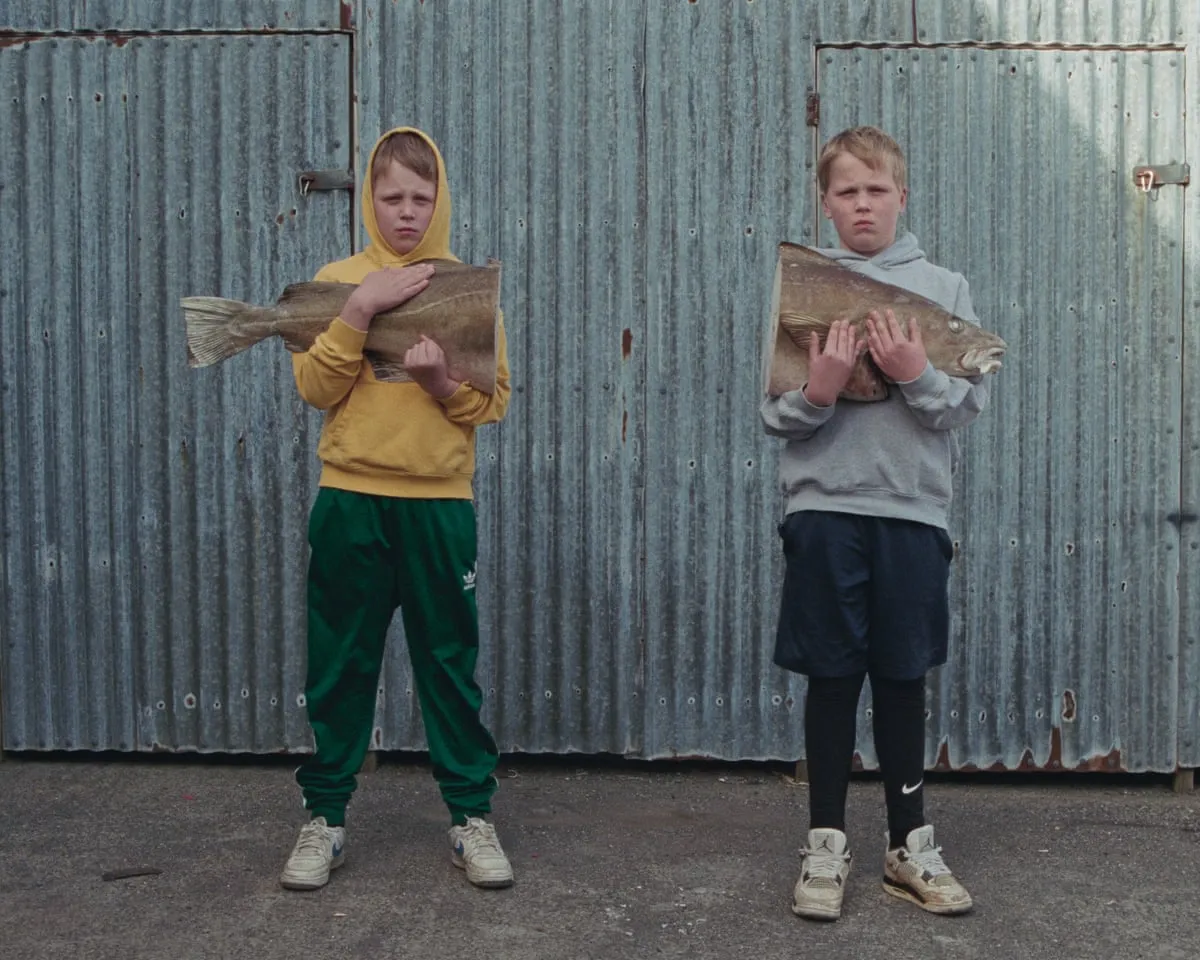A fractured family clinging to fragments of love (or at least what remains) is the emotional core of The Love That Remains, Hlynur Pálmason’s intimate study of separation and the ghosts it leaves behind. In this Icelandic drama, which premiered in the Cannes Première strand in May 2025, Pálmason reunites with his real-life children—Ída, Þorgils, and Grímur—to chronicle the liminal space between togetherness and divorce.
Magnus (Sverrir Guðnason), a herring-trawler sailor, drifts between isolation at sea and awkward visits to the family homestead; Anna (Saga Garðarsdóttir), an artist who loses her harbour-side studio to a crane’s wrenching lift, oscillates between exasperation and pity as she co-parents their three children.
Playful absurdity undercuts melancholy throughout—a jazz-infused piano score threads through fantasy sequences that puncture the film’s realist veneer. Yet the film’s true distinctiveness lies in its collage structure: scenes that snap-cut from domestic picnics to dream logic, refusing linear catharsis in favor of emotional montage. What remains is a work that fuses grounded grief with surreal interludes, carving out a cinematic space where private lore and public spectacle overlap.
Canvas of Ice and Imagination
Iceland’s windswept plains aren’t mere backdrop but a co-protagonist: Academy-ratio master shots frame Magnus and Anna as tiny figures against vast emptiness, a reminder that personal upheaval often mirrors environmental indifference. Unlike the savage vistas of Pálmason’s earlier Godland, here the land invites imagination—snow-capped ridges become playgrounds for memory.
Symmetry and depth of field recur: a medieval helmet on a pole echoes the sword that suddenly plummets nearby (in-camera trickery that feels like a slapstick deus ex machina). Anna’s metallic land art—rusted canvases, splintered wood—feeds into an earthy palette, contrasting with the trawler’s steely grays, signifying the tension between grounded life and creative impulse.
Fantastical interludes arrive unannounced: a giant rooster (CG-enhanced yet strangely tactile) emerges from Magnus’s nightmare, stalking him as much as his own thwarted ego. A Second World War sea mine, real or imagined, snarls in his nets—a visual metaphor suggesting latent domestic explosives. These flourishes communicate Magnus’s psychological state more eloquently than dialogue ever could.
Collage of Memory and Myth
The film unfolds as a series of vignettes rather than a linear tale. Consider five pivotal beats: Anna’s studio stripped bare by crane; Magnus’s cabin-life aboard the trawler; a picnic-cum-swim interlude that veers into erotic hallucination; the rooster’s on-land assassination; an archery accident that animates a suit-of-armor target. Each sequence fractures time and perspective, asking: is this memory, fantasy, or both?
The boundary between real and imagined is porous. When Magnus watches Anna up close, that ecstatic upskirt vision may be longing or pure invention—an indictment of post-separation loneliness. The massive rooster isn’t merely absurd; it’s masculinity enlarged to grotesque proportions. The WWII mine that appears near his vessel resonates like historical trauma, a reminder that past conflicts—national or personal—never fully sink.
Symbolically, the stripped roof of Anna’s studio signals domestic collapse; the rust stains on her canvases mirror the persistence of marital decay. Themes of isolation, the persistence of memory, and the tug-of-war between affection and exasperation in co-parenting pulse through these motifs. Magnus drifts from hopeful petitioner to ghost-like intruder—warm family moments (the picnic’s laughter) are tempered by the growing gulf that even fantasy can’t bridge.
Portraits in Disruption
Sverrir Guðnason’s Magnus is an exercise in muted desperation: slumped shoulders, hollow glances, a man at sea both literally and figuratively. His physicality (the way he cradles the rooster’s corpse or drifts buoyant in icy water) speaks volumes about thwarted agency. A dry aside: never has killing fowl felt so existential.
Saga Garðarsdóttir’s Anna balances compassion and exasperation with surgical precision. When she surveys her gutted studio—roof gone, roof gone, roof gone—her face registers both loss and a grim determination to rebuild. Her sparring with a patronizing Swedish gallerist (who departs in a sputtering plane) reveals the professional pressures that compound marital strain.
The children—Pálmason’s actual offspring—offer naturalism that grounds the film’s flights of fancy. Their archery-target stunt, innocent until one arrow flies astray, transforms family play into portent. Ingvar Sigurdsson’s cameo as grandfather adds a resonant paternal echo: generational grief, perhaps.
On-screen chemistry crackles with shared history: Magnus’s hesitant embrace of Ida, Anna’s reluctant smile at Þorgils’s joke. These interactions, brief and often awkward, create a living archive of love that remains—flawed, unfinished, and profoundly human.
The Love That Remains premiered in the Cannes Premiere section at the 2025 Cannes Film Festival on May 18, 2025.
Full Credits
Director: Hlynur Pálmason
Writer: Hlynur Pálmason
Producers: Anton Máni Svansson, Katrin Pors
Co-Producers: Mikkel Jersin, Eva Jakobsen, Nima Yousefi, Didar Domehri, Anthony Muir, Kristina Börjeson, Olivier Père, Rémi Burah
Cast: Saga Garðarsdóttir, Sverrir Gudnason, Ída Mekkín Hlynsdóttir, Þorgils Hlynsson, Grímur Hlynsson, Ingvar Sigurðsson, Anders Mossling, Katla Margrét Þorgeirsdóttir, Kristinn Guðmundsson, Halldór Laxness Halldórsson
Director of Photography (Cinematographer): Hlynur Pálmason
Editor: Julius Krebs Damsbo
Composer: Harry Hunt
The Review
The Love That Remains
The Love That Remains is a quietly affecting mosaic of grief and whimsy, anchored by stark Icelandic vistas and piercing performances. Pálmason’s episodic approach can feel elusive, yet its dreamlike detours reveal the ache of separation in ways dialogue cannot. Its symbolism occasionally drifts into artifice, but its emotional honesty and visual clarity linger long after the credits roll.
PROS
- Evocative Icelandic landscapes that double as emotional barometers.
- Nuanced performances—especially Sverrir Guðnason’s quietly desperate Magnus.
- Inventive use of surreal interludes to externalize inner turmoil.
- Collage structure that mirrors the fragmented nature of memory.
- Naturalistic chemistry among the real-life family cast.
CONS
- Episodic pacing can feel disjointed, risking emotional detachment.
- Symbolism (giant rooster, mines) sometimes veers into artifice.
- Ambiguity between fantasy and reality may frustrate viewers seeking clarity.
- Occasional tonal whiplash between dry humor and melancholy.
